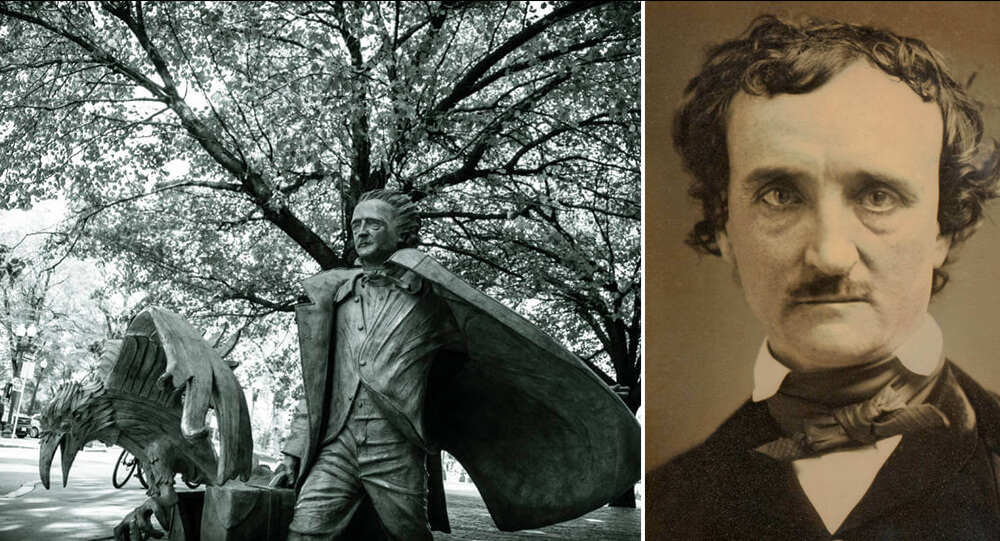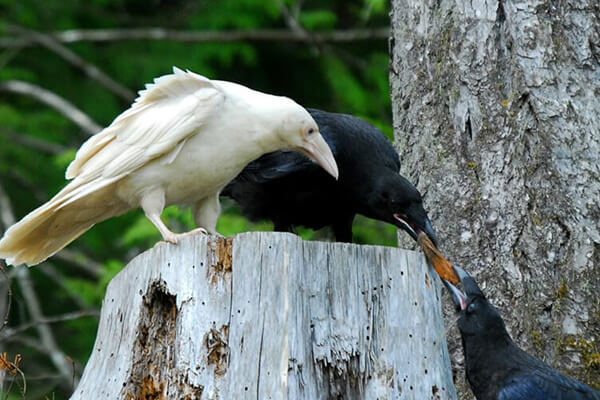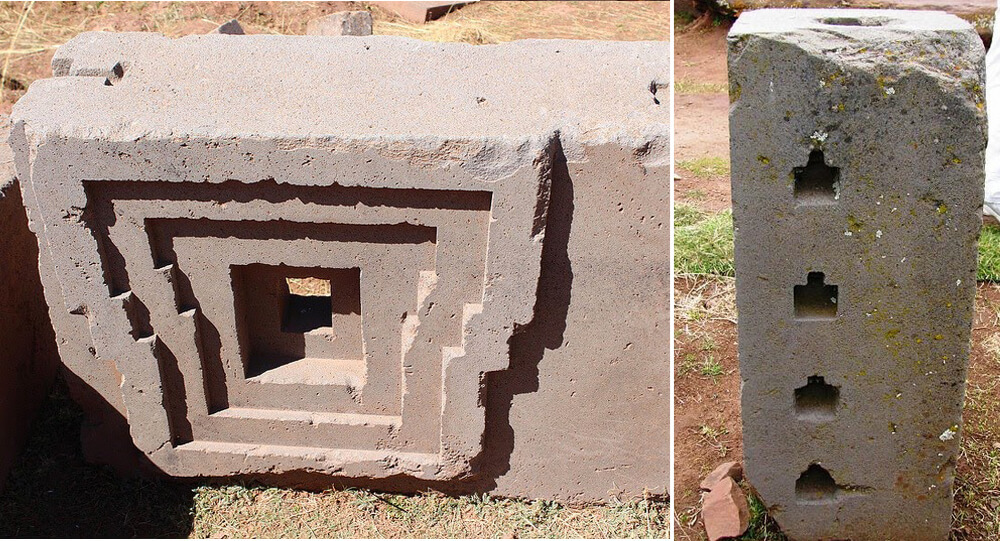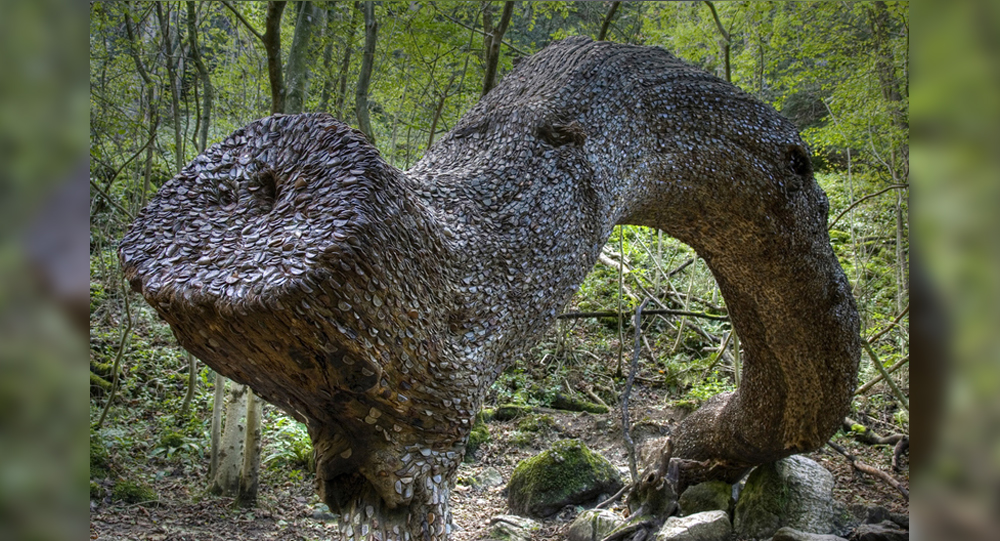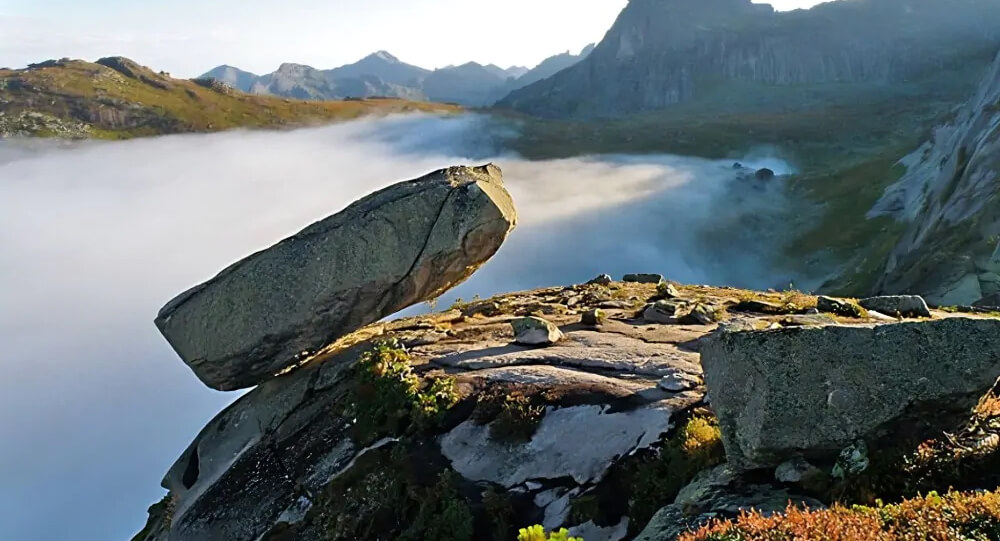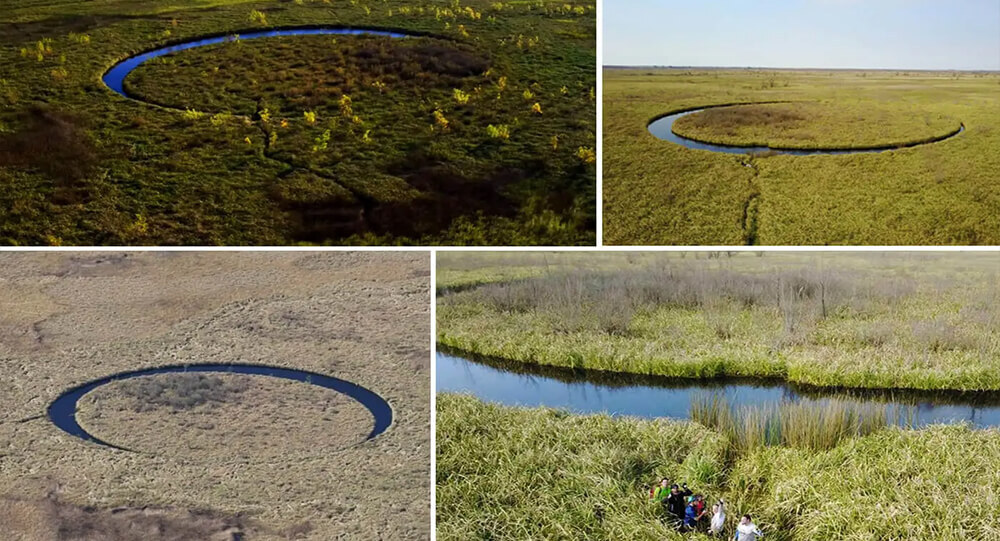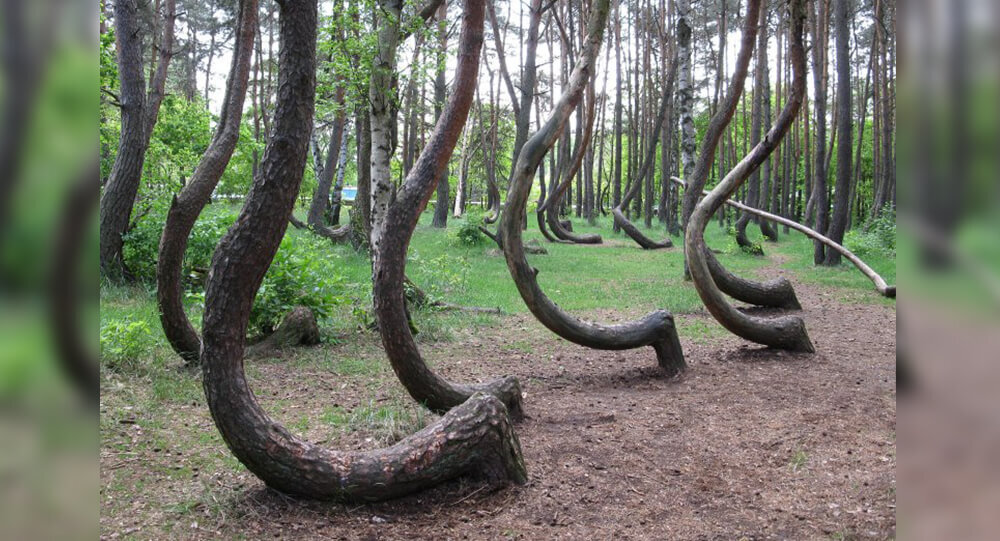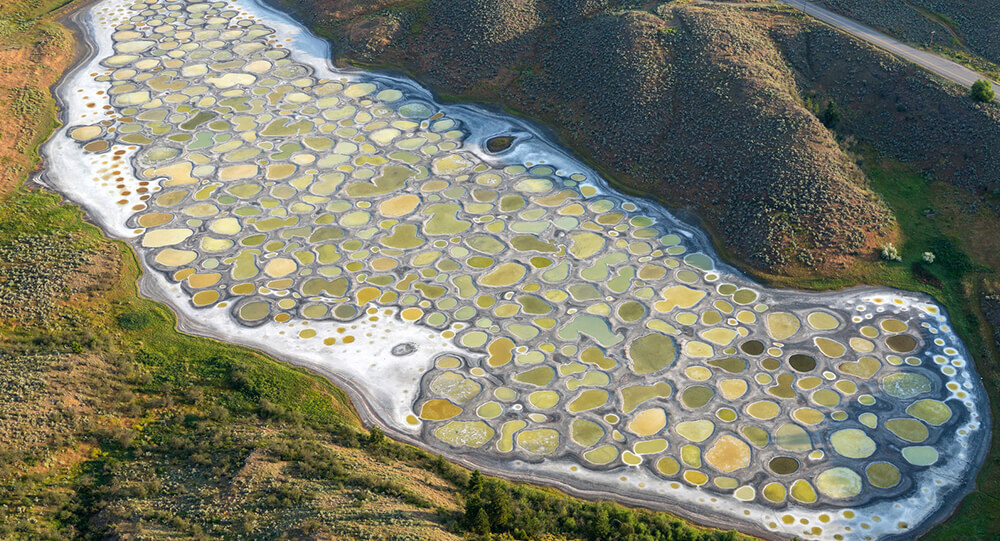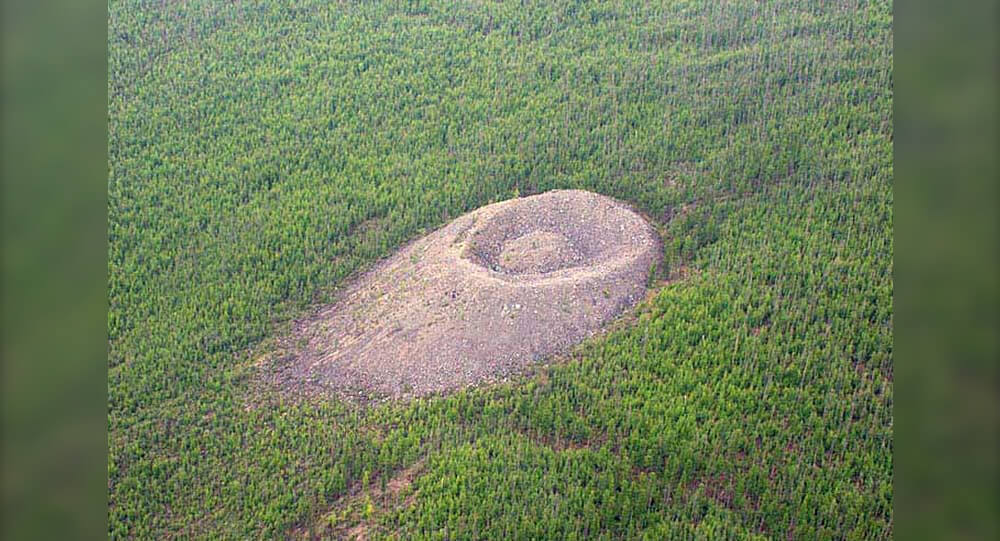
A geologist named Vadim Kolpakov discovered a strange feature on the earth’s surface in the Bodaibo, Irkutsk region of South-Eastern Siberia in the summer of 1949. This anomaly is oval, surrounded by trees, and has a conical crater in the center with a small ball-like mound. The entire structure is made of shattered grey limestone. It has a width of 130-160 meters and a height of up to 80 meters. Surprisingly, few trees grow on the formation; however, the surrounding conifers have grown rapidly. The geologic mystery, known as the Patomskiy Crater, the Kolpakov Cone, and the Fire Eagle Nest, has perplexed scientists who are unsure what caused this unusual formation.
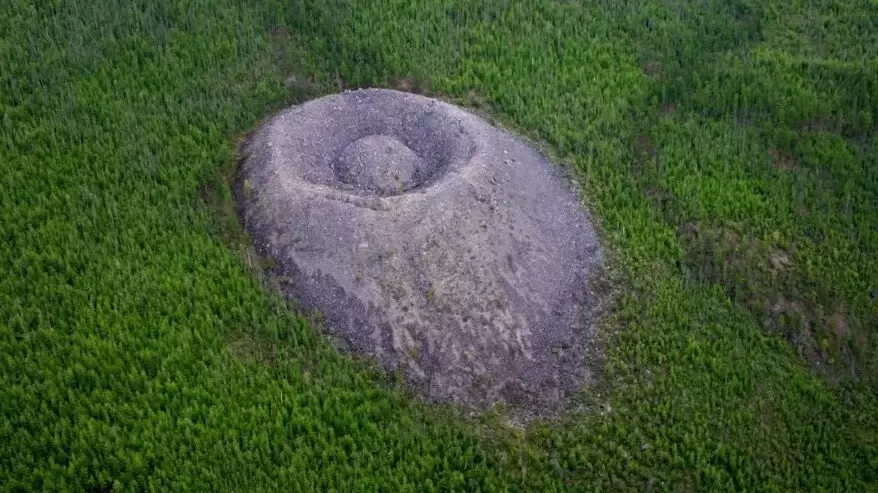
Far Out Theories on the Patomskiy Crater
I don’t know if it is a meteorite or a spaceship, but there is definitely something under the crater.
The Patomskiy crater, named after the nearby river, has given rise to a plethora of intriguing theories. There were wild theories that it was a covert uranium mine from Stalin’s era that employed Gulag laborers. It was the landing site of an alien UFO, according to theories put forth by ancient astronauts. Other widely accepted theories include the Tunguska Event, a cylindrical metallic object of unknown origin, a dust-sized meteorite that burrowed through the planet and left the crater as an exit wound, and an underground uranium or natural gas explosion.
It might seem unlikely that uranium exists. But it’s well known that there are a lot of naturally occurring radioactive elements in this region. An explosion could occur under certain conditions, but it is possible. A precise set of events would have to occur. The trees, however, do not show signs of significant uranium explosions or the Tunguska disaster, which would have destroyed the conifers.
The most possible theory, by far, is that the peculiar shape of the Patomskiy crater was caused by an extraterrestrial or alien body that had lodged there a long time ago. An object from space would leave far higher radioactive levels than the average levels on Earth, which seems to contradict the unremarkable radiation levels. Of course, one could argue that since the spacecraft landed so long ago, the high levels have already returned to nominal. The enlargement of the surrounding vegetation lends credence to this.
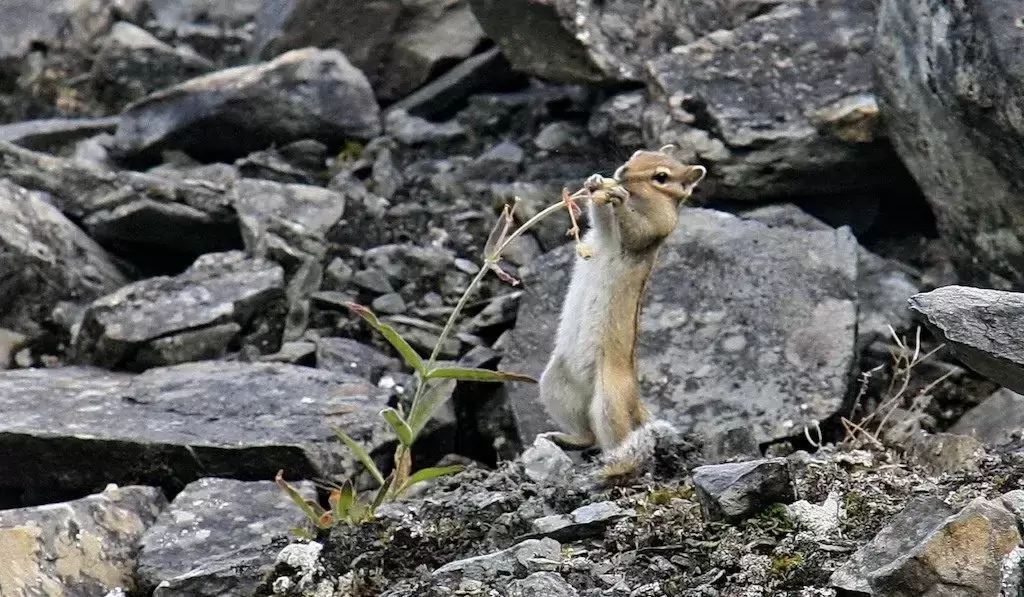
Science at the Crater
Initially, the two most probable theories proposed that the origin is either volcanic or meteoric. The issue is that there is currently no proof of either scenario discovered by scientists on the Siberian crater’s slopes. Nowhere is there meteor debris or volcanic rock. Even so, the location reminded scientists of the lunar impact marks left by meteor strikes, and they surmised that more evidence might be found farther down in the earth, closer to the meteor’s explosion. Most scientists have given up on the meteor hypothesis because, at this point, the bulk of the evidence has ruled it out.
Local Legend of Bad JuJu at the Crater
The Yakut are an indigenous people living in the remote Irkutsk region. These individuals insist that big animals stay out of the crater because they view it as a dangerous location. According to one explanation of this superstition, it’s possible that their ancestors lived in the region when radiation levels were much higher. It’s possible that this radiation caused these ancestors’ illnesses and deaths. The legend was combined over time to create oral tribal tales that were ingrained in Yakut culture. In fact, the crater’s shape led the Yakut to name it Fire Eagle’s Nest.

Investigations of the Fire Eagle Nest
Despite being found in 1949, the Patomskiy crater was not thoroughly investigated until 2005, when the first scientific expedition set out to do so. This delay was caused by several factors, whereas in many other nations, a phenomenon of this size would have drawn attention from scientists. Prioritizing military development was the focus of scientific spending until the fall of the Soviet Union. As a result, the crater’s study was delayed.
Evgeny Vorobyov, the lead researcher, died while hiking shortly after they set out for their target in 2005, which was a major setback for the initial expedition. An autopsy revealed a massive heart attack when authorities recovered his body (Zubacheva 2013). Nevertheless, the group continued regardless of the negative sign. Despite extensive scientific research, the field only opened up new opportunities. They were unable to determine its cause definitively at that point. Surprisingly enough, though, a number of anomalies were found nearby.
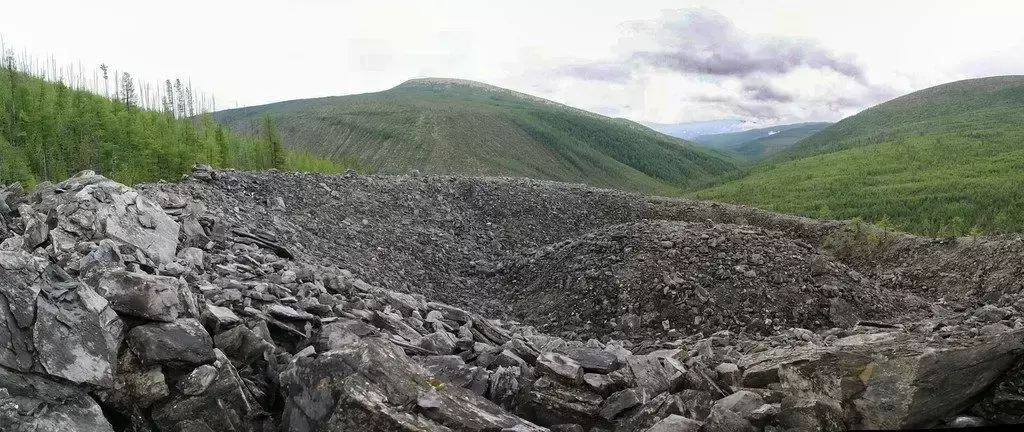
Strange Surroundings
The Russian government was initially worried that this could be the location of a nuclear test by another country because it was around the start of the Cold War. It was after all, only three years earlier that the Americans had used nuclear weapons against Japan, and it was well known that the Russians were trying to develop the same technology.
As a result, elevated radiation levels were among the first things officials looked for at the site. The outcomes, though, were not noteworthy. The amount, while marginally higher than nominal, did not suggest a nuclear explosion.
What is puzzling, though, is that for more than a century prior to its discovery, the surrounding vegetation saw a significant increase in size. Although it may sound harmless, nuclear contact frequently results in this anomaly. Radiation’s mutagenic effects have an impact on flora, frequently leading to a gradual but significant increase in its size. This also applied to the surrounding vegetation of Chernobyl. There are also magnetic anomalies on the strange Patomskiy crater and in the area around it. Of course, there are additional reasons for growth spurts in trees.
Recent Revelations About the Patomskiy Crater
According to contemporary geomorphologists, the Fire Eagle’s Nest might be an extremely uncommon gas volcano that vents enormous underground gas reserves. The peculiar rock formations might also be a sign of chemical reactions between elements leaking through from deep within the earth and those on the surface.
According to Dmitry Demezhko of the Institute of Geophysics in Yekaterinburg, the crater formed in two stages. First, a channel resembling mud volcanism was formed in the region by tectonic activity. The rock eventually started to fracture as a result of constant freezing and thawing.
A 2015 paper by V.S. published one of the most recent studies. B.G. Pokrovsky, Antipin, and A.M. According to Fedorov, the formation happened as a result of one or more steam explosions that happened when magma rose through the rock and water or when fissures released pressurized water that was trapped in the rock.
Experts are gradually approaching a definitive solution to this perplexing mystery, if they haven’t already. It seems that all scientists agree that the Patomskiy crater is unique to our planet and cannot be found anywhere else.

The Unsolved mystery of Bobby Dunbar's Disappearance
In 1912, a four-year-old boy named Bobby Dunbar went missing on a family trip, 8 months later he was found and reunited with his family. Nearly a century later, DNA testing of his descendants revealed that the child reunited with the Dunbar family was not Bobby, but rather a boy named Charles (Bruce) Anderson who resembled Bobby.

The mysterious secret of Dr James Barry
Before women were allowed to enroll in medical school, Margaret Ann Bulkley studied medicine and assumed the identity of Dr. James Barry for 56 years while dressing as a man. After 46 years of service as an army doctor officer, her secret was not made public until after her death in 1865.

Qasr al-Farid, the Lonely Castle of the Nabataeans
The remote tomb of Qasr al-Farid, situated in the Saudi Arabian desert, dates back to the 1st Century CE. It was built by the Nabataean people, who also built Petra in Jordan. This site has remained largely undisturbed.

The Forgotten Story of Marilyn Monroe’s Stolen Dress That Returned Years Later
One of Marilyn Monroe’s most iconic gowns vanished mysteriously, disappearing into the shadows of Hollywood history. This garment, often regarded as a symbol of glamour and tragedy, slipped away for decades before resurfacing under enigmatic circumstances. Whispers of underground auctions, secret collections, and ghostly legends hint at a fascinating and almost cinematic journey for a dress that once captivated a nation. This article uncovers the intriguing saga of Marilyn Monroe’s stolen dress, tracing its path back into the public eye and exploring its lasting cultural significance.

The mystery of India's 'lake of skeletons'
In 1942, a British forest guard in India made an alarming discovery. Some 16,000 feet above sea level, at the bottom of a small valley, was a frozen lake absolutely full of skeletons.

Lightning bolt restores man’s sight and hearing.
In 1980, an old blind and partially deaf man, Edwin Robinson, was struck by lightning. He suffered no injuries, but the impact of the lightning bold cured his vision and hearing.

Mysterious ghost ship found with mummified captain inside [SOLVED]
German captain had been sailing the world for 20 years. It was unknown when or how he died or how long the ghost ship had been adrift

The Mystery of the Dancing Forest: Reasons behind the unusual wonders of forest
The Dancing Forest in Russia is noted for its unusually twisted pine trees. The trunks of these trees are contorted into spirals, rings, and other squiggly loops, but the reason for this malformation is still a mystery.

Death Valley’s sailing stones mystery SOLVED
The mysterious "sailing stones" of Death Valley have confused experts for years. The massive stones appear to travel over the dried lake bed known as Racetrack Playa in California's Death Valley National Park, leaving a path in the cracked mud behind them.

The Mysterious Disappearance of Frederick Valentich: Australia’s Most Baffling Aviation Enigma
In 1978, Pilot Frederick Valentich and his plane disappeared in Australia. His last communication was “Melbourne that strange aircraft is hovering on top of me again… (two seconds open microphone)… it is hovering and it’s not an aircraft…”

[solved] “macaroni mystery”, 500 pounds of pasta dumped in new jersey
In April 2023, Old Bridge, New Jersey, faced a peculiar 'Macaroni Mystery' when 500 pounds of pasta were mysteriously dumped in the woods.

Inside The Mysterious Death Of The Famed Gothic Writer Edgar Allan Poe
Hours before his death Edgar Allen Poe was found on the streets of Baltimore. He was incoherent, wearing another man’s clothes, and unable to explain how he got there. The cause of his death is an unsolved mystery.

The birth or sign language in Nicaragua
When 50 deaf Nicaraguan children who did not know sign language were placed in the same classroom, they created their own sign language. Scientists are still researching the unique spontaneous appearance of language, as well as its own evolution and training of grammar.

10 Rarest and Albino animals you haven’t seen
For centuries, people have been fascinated and enchanted by the ghostly appearances of abnormally white animals. People have loved albinos and other unusually white animals so much that they may be helping to increase their numbers, despite the difficulties these animals face in the wild. While these unusual animals did not win the genetic lottery, they have persevered in the face of adversity.

Lucy and Maria The Biracial Twin Sisters with Rare Black and White Skin Colours
Lucy and Maria Aylmer are twins, but they have a hard time to convincing people. Even though they have mixed-raced parents, their mom was still shocked when the midwife handed her babies she’d expected to look alike, but were complete opposite.

The Remarkable story of jazz bassists Henry Grimes, lost but found as janitor and reclaimed the spotlight
Henry Grimes, one of the most versatile jazz bassists, disappeared in the 1960s and was later presumed dead. However, a jazz-loving social worker found him in 2002 working as a janitor in a hotel. Grimes found his way back into the limelight when a fellow musician sent him a bass as a gift. In 2016, he received a lifetime achievement award.

The Mystery of Puma Punku’s Precise Stonework
Pumapunku's stone blocks were meticulously carved and polished to interlock with neighboring stones, forming a puzzle-like structure. The joints between them are incredibly precise. These characteristics show an intricate knowledge of descriptive geometry and stone cutting, indicating the use of highly advanced technology that would have seemed impossible at the time.

The Mystical Money Tree of the Scottish Highlands: A 1,700-Year-Old Tradition
In the Peak District Forest of the Scottish Highlands in the UK, there is a unique tree which is laden with only money. This tree laden with money has been studded with British coins for 1700 years, there is no corner of its trunk where a British coin is not stuck.

The Amazing Hanging Stone in Siberia Has Defied Gravity Since the Ice Age
The unbelievable "Hanging Stone" of Siberia weighs around 300 tons and has been hanging off a 1,000-meter cliff since the Ice Age.

El Ojo, The Mysterious Rotating Island
In the middle of South America, a strange and nearly perfectly circle island moves on its own. The central landmass, known as 'El Ojo' or 'The Eye,' floats on a pond of clear and chilly water, looking strange and out of place in comparing to its surroundings. The bottom appears to be solid in compared to the marsh around it.

Poland's Krzywy: The Mysteries of the Crooked trees
In Poland, there is a forest with 400 crooked trees that have a 90-degree bend at the base of their trunks. Despite of numerous possibilities, the real reason and how it evolved remain a mystery.

The Heartbreaking Story Of Ella Harper, The ‘Camel Girl’
Ella Harper, Professionally known as the “Camel Girl” was born with a rare orthopedic condition that cased her knee to bend backward. Due to this condition, had to walked on all four legs, which resulted in her nickname as “Camel Girl”. Tough it was hard at first, but soon she made a fortune out of it.

What Was the Beast of Gévaudan?
Between 1764 and 1767, a mysterious animal called the Beast of Gévaudan terrorized the French village called Gévaudan. It attacked and killed about 100 adults and children. While most believe it was a wolf, some say it may have been a wolf-dog hybrid, hyena or even a lion, but without any genetic evidence, the beast will remain a mystery forever.

The Mystery of Canada's Magical Spotted Lake
Lake Khiluk, the world's most mineralized lake, and one of the most mysterious places on Earth. Each of these spots has a distinct chemical content and is said to cure various diseases.

Chocolate Rain in Switzerland: How a Factory Malfunction Turned Olten Into a Sweet Spectacle
In 2020, chocolate 'rained' from the sky in a town in Switzerland. This incident was caused by a ventilation system malfunction at a chocolate factory in Olten. Strong winds then carried the snow-like cocoa powder and spread it around in the immediate vicinity of the factory, covering cars and other things in chocolate.



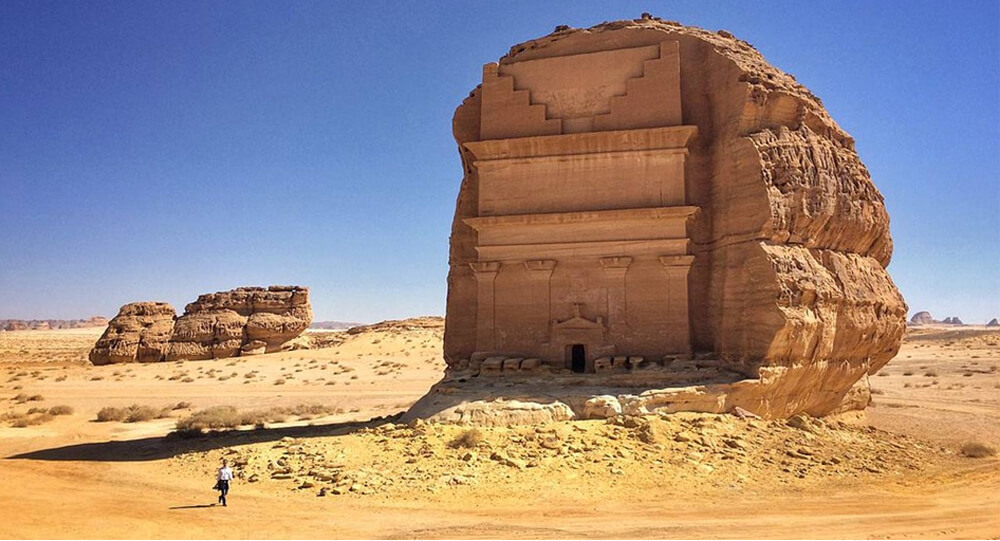

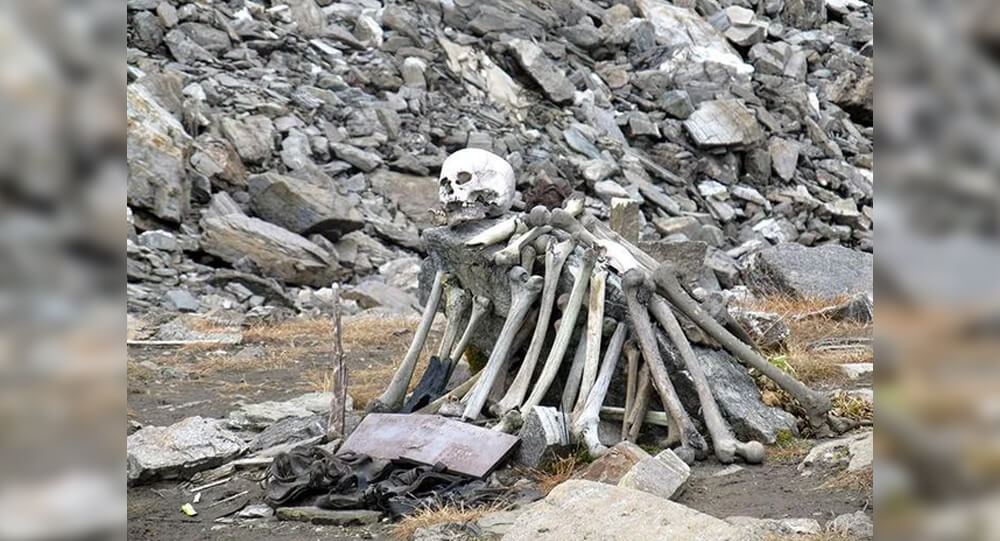

![Mysterious ghost ship found with mummified captain inside [SOLVED]](https://weeklyrecess.com/wp-content/uploads/2024/07/Solved-Mysterious-ghost-ship-with-mummified-captain-cover.jpg)
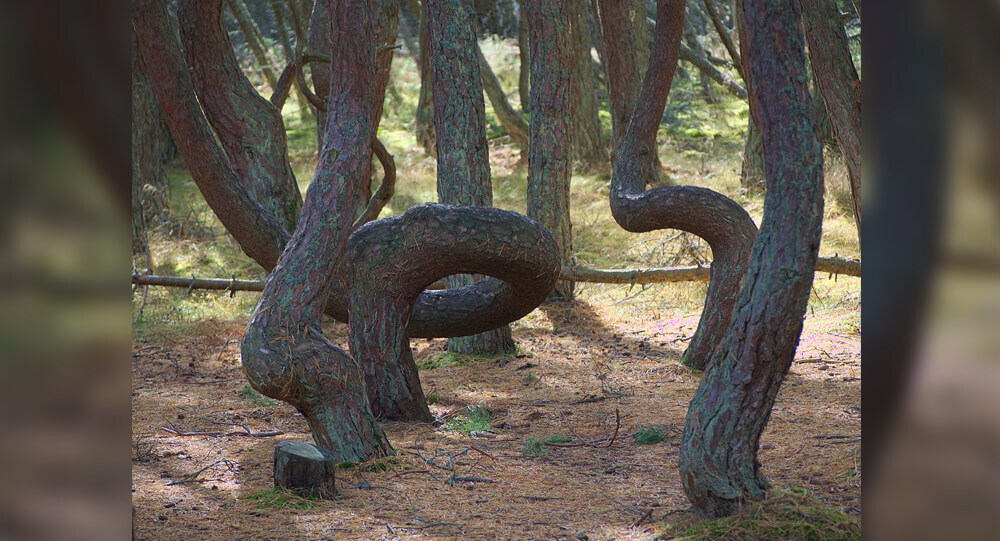
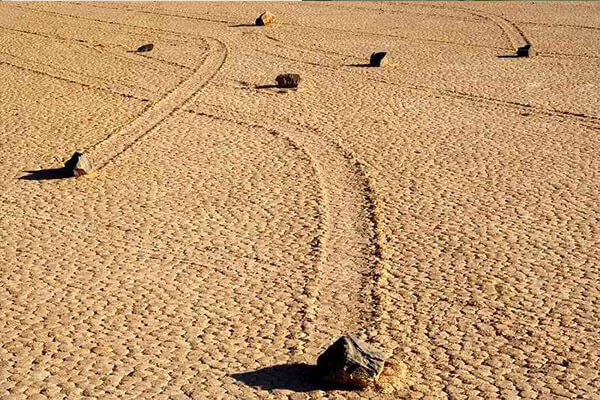

![[solved] “macaroni mystery”, 500 pounds of pasta dumped in new jersey](https://weeklyrecess.com/wp-content/uploads/2024/05/Macaroni-Mystery-cover.jpg)
